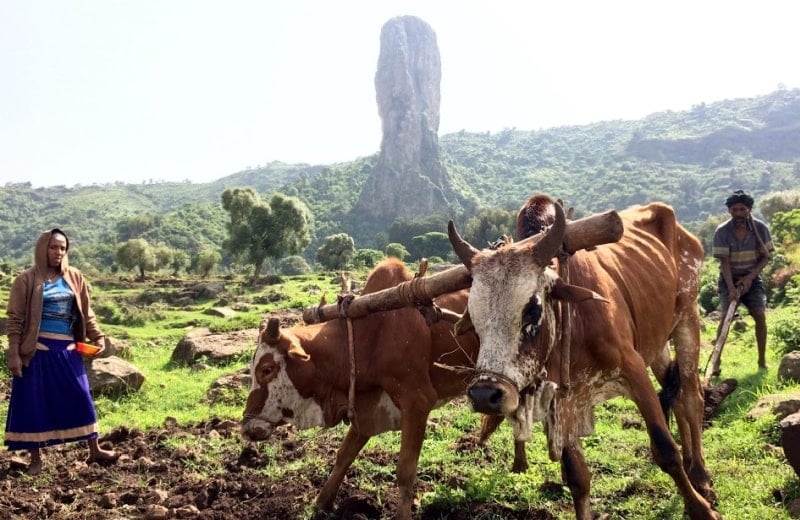USAID & anticipatory action: Thirty-five years of forecast-based early response

Since developing famine forecasting capacity in the 1980s, USAID continues to invest in anticipatory approaches in its humanitarian operations. Recently it set up the Academic Alliance on Anticipatory Action to stimulate deeper research.
FEWS NET: Preventing famine in Ethiopia
In 1984-85, a devastating drought in Ethiopia led to crop failure, livestock losses, and famine. Hundreds of thousands of men, women and children perished, shocking the world.
In response, the US Agency for International Development (USAID) created the Famine Early Warning Systems Network – known as FEWS NET.
When Ethiopia experienced another exceptional, year-over-year drought in 2015–16, the country suffered crop and livestock losses and water shortages. However, this time FEWS NET provided warning of the drought in advance, and USAID took early, robust action.
In partnership with the Government of Ethiopia, social safety nets were put in place to protect 8 million people. USAID mobilized $800 million and provided 680,000 tons of food assistance to 4 million people. These early interventions meant that emergency food insecurity and famine were prevented.
FEWS NET's work in Ethiopia is an example of the anticipatory approach: using early warning of an impending hazard, swiftly followed by early action, to save lives.
The success of FEWS NET reflects 25 years of local, in-country investments. Field offices are increasingly staffed by locally-recruited professionals who gather and analyze data to inform FEWS NET’s food security outlooks. This combination of local expertise and world-class analytical capabilities gives USAID an edge in responding early to humanitarian crises.

Data, partnerships and strategic finance
Since setting up FEWS NET, USAID has continued to support the growth of anticipatory and early action:
- First, by investing in data that serves as the foundation of forecasting, early warning, and risk assessment.
- Second, by working with partners to implement evidence-based risk-informed early actions and decision-making.
- Third, by seeking to scale the strategic layering of different kinds of crisis financing, including anticipatory action and innovative risk financing instruments, while making sure that they respect humanitarian principles.
Reliable data and skilled forecasts play a central role in scaling anticipatory action: it is vital to invest in early warning systems and high-quality data to feed those systems.
Early action requires policies, plans, resources and mechanisms that are put in place in advance, to provide sufficient lead time for early and efficient action.
Finally, it is critical to understand the vulnerability and capacity of communities and countries.
Filling in knowledge gaps
To scale up anticipatory action in the humanitarian sector we need to build our understanding. There are important efforts underway to better define the terminology around anticipatory action, as well as examining how donor countries account for their investments in this space.
The project has seven separate research workstreams on topics ranging from nutritional interventions around flooding to social protection programs during drought; from cost-effective risk layering for cyclone-related floods to research on the impact of heatwaves on people in Central and South American cities.
Plan, prepare, and reduce disasters’ impacts
The disaster risk reduction and risk financing communities must be key stakeholders in humanitarian and development efforts to elevate anticipatory action.
This can be achieved by capitalizing on investments by the international community – including USAID – in early warning systems, and advancing the capacity of communities and governments to plan, prepare for, and reduce the impacts of disasters before they happen.
USAID’s investment in building evidence for anticipatory action aims to intentionally and strategically layer emergency and risk-informed approaches, while building local capacity, without displacing life-saving humanitarian assistance.
This requires that we gather data on what works well and provides value in anticipatory action to inform future investments – one of the primary aims of the 4A’s project.
Practical results in Vietnam
In addition to USAID’s work in scaling up and investing in knowledge, we continue to use anticipatory approaches for our in-country work.
In Vietnam, for example, we support forecast-based financing through a program in partnership with the Vietnam Red Cross (VNRC). Data and forecasts provided by national meteorological and hydro-meteorological agencies allow users to project potential impacts on communities and enable countries to take early action.
When experts forecast a storm that meets the trigger threshold, the financing model is automatically activated. VNRC then actively shares information with local counterparts, makes decisions on how to spend the funds, and implements storm preparedness and response plans – like reinforcing house structures in advance of the storm, supporting evacuations, and conducting needs assessments after the storm.
